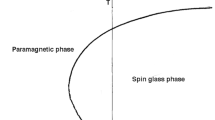Abstract
In this note we explain the use of the cavity method directly at zero temperature, in the case of the spin glass on a lattice with a local tree like structure, which is the proper generalization of the usual Bethe lattice to frustrated problems. The computation is done explicitly in the formalism equivalent to “one step replica symmetry breaking;” we compute the energy of the global ground state, as well as the complexity of equilibrium states at a given energy. Full results are presented for a Bethe lattice with connectivity equal to three. The main assumptions underlying the one step cavity approach, namely the existence of many local ground states, are explicitely stated and discussed: some of the main obstacles towards a rigorous study of the problem with the cavity method are outlined.
Similar content being viewed by others
REFERENCES
M. Mézard, G. Parisi, and M. A. Virasoro, Europhys. Lett. 1:77(1985).
M. Mézard, G. Parisi, and M. A. Virasoro, Spin Glass Theory and Beyond (World Scientific, Singapore, 1987).
O. C. Martin, R. Monasson, and R. Zecchina, Theor. Comp. Sci. 256:3-67 (2001), and references therein.
M. Mézard, G. Parisi, and R. Zecchina, Science 297:812(2002); M. Mézard and R. Zecchina, cond-mat/0207194.
M. Mézard, F. Ricci-Tersenghi, and R. Zecchina, condmat/0207140.
S. Cocco, O. Dubois, J. Mandler, and R. Monasson, cond-mat/0206239.
M. Talagrand, Probab. Theory Related Fields 110:109(1998).
A. Bovier and B. Niederhauser, cond-mat/0108235.
M. Mézard and G. Parisi, Eur. Phys. J. B 20:217(2001).
An alternative derivation of the energy density goes as follows. In the limit of large N and q, with q ≪ N we must have:E(N, q)=NU + qR + O(q2/ N)) We easily find that 2R=-δE(2)U-(k+1) R=δE(1). Solving the previous equation we recover Eq. (7). Under this last form the argument may be easily generalized to lattices with random connectivity.
M. W. Klein, L. J. Schowalter, and P. Shukla, Phys. Rev. B 19:1492(1979).
S. Katsura, S. Inawashiro, and S. Fujiki, Phys. A 99:193(1979).
K. Nakanishi, Phys. Rev. B 23:3514(1981).
D. R. Bowman and K. Levin, Phys. Rev. B 25:3438(1982).
D. J. Thouless, Phys. Rev. Lett. 56:1082(1986).
J. T. Chayes, L. Chayes, J. P. Sethna, and D. J. Thouless, Commun. Math. Phys. 106:41(1986); J. M. Carlson, J. T. Chayes, L. Chayes, J. P. Sethna, and D. J. Thouless, Europhys. Lett. 5:355 (1988).
M. Mézard and G. Parisi, Europhys. Lett. 3:1067(1987).
I. Kanter and H. Sompolinsky, Phys. Rev. Lett. 58:164(1987).
J. M. Carlson, J. T. Chayes, L. Chayes, J. P. Sethna, and D. J. Thouless, J. Statist. Phys. 61:987(1990); J. M. Carlson, J. T. Chayes, J. P. Sethna, and D. J. Thouless, J. Statist. Phys. 61:1069 (1990).
It is easy to check that this expression is equal to the zero temperature limit of the general finite temperature iteration formula used in ref. 9.
C. De Dominicis and P. Mottishaw, J. Phys. A 20:L375(1987).
P. Mottishaw, Europhys. Lett. 4:333(1987).
R. C. Dewar and P. Mottishaw, J. Phys. A 21:L1135(1988).
P. Y. Lai and Y. Y. Goldschmidt, J. Phys. A 22:399(1989).
C. De Dominicis and Y. Y. Goldschmidt, J. Phys. A 22:L775(1989); and C. De Dominicis and Y. Y. Goldschmidt Phys. Rev. B 41:2184 (1990).
E. J. Gumbel, Statistics of Extremes (Columbia University Press, NY, 1958).
J.-P. Bouchaud and M. Mézard, J. Phys. A 30:7997(1997).
One could use the expression imprecise probabilities to describe this situation.
G. Parisi, J. Phys. A 13:L115, 1101, 1887 (1980).
D. Sherrington and S. Kirkpatrick, Phys. Rev. Lett. 35:1792(1975).
R. Monasson, Phys. Rev. Lett. 75:2847(1995).
F. Guerra, Broken Replica Symmetry Bounds in the Mean Field Spin Glass Model, cond-mat/0205123.
K. Y. Wong and D. Sherrington, J. Phys. A 21:L459(1988).
Y. Y. Goldschmidt and P.-Y. Lai, J. Phys. A 23:L775(1990).
A. Montanari, Eur. Phys. J. B 23:121(2001).
S. Franz, M. Leone, F. Ricci-Tersenghi, and R. Zecchina, Phys. Rev. Lett. 87:127209(2001).
D. J. Thouless, P. W. Anderson, and R. G. Palmer, Phil. Mag. 35:593(1977).
A. J. Bray and M. A. Moore, J. Phys. C 13:L469(1980).
C. De Dominicis, M. Gabay, T. Garel, and H. Orland, J. Phys. 41:923(1980).
G. Biroli and R. Monasson, Europhys. Lett. 50:155(2000)
A. Cavagna, I. Giardina, M. Mézard, and G. Parisi, in preparation.
K. Nemoto and H. Takayama, J. Phys. C 18:L529(1985).
Author information
Authors and Affiliations
Rights and permissions
About this article
Cite this article
Mézard, M., Parisi, G. The Cavity Method at Zero Temperature. Journal of Statistical Physics 111, 1–34 (2003). https://doi.org/10.1023/A:1022221005097
Issue Date:
DOI: https://doi.org/10.1023/A:1022221005097



